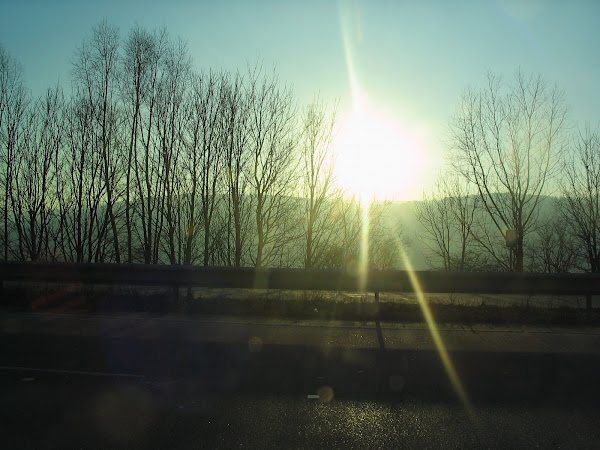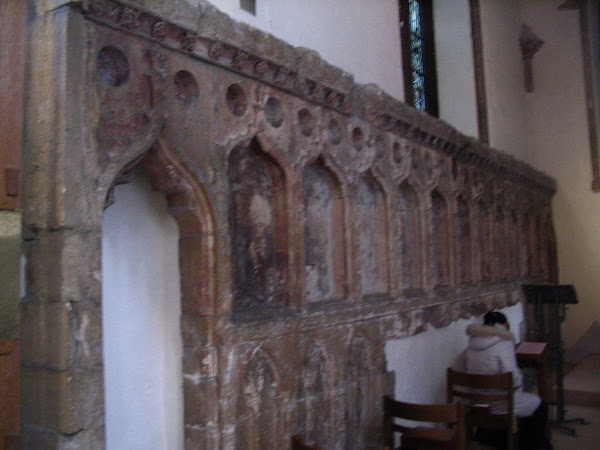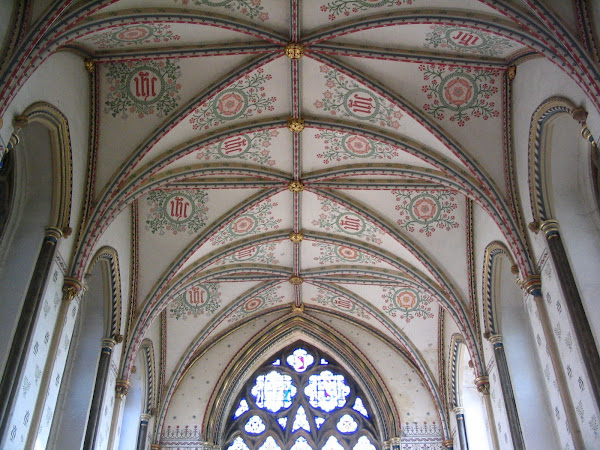 ______________________________________________________________________________________________
______________________________________________________________________________________________The next five pictures are about Goldcliff's 'Mother House' in Normandy (1) Also a sea side location, perhaps these monks had special skills in sea defences and fishing.....Perhaps it is why Robert de Chandos offered it to Bec. Wool was an important commodity as were fruit farms and arable land. Goldcliff owned lands at Membury, Caerleon (Churches of Julius and Aaron and all their lands) and most of the surrounding area.
The Archbishop of Canterbury visited Bec recently, as you can see. Bec is a thriving Benedictine Community again, has a guesthouse where people can stay for retreats and rest, and there are many businesses undertaken by monks to pay for the outkeep of the monastery. Goldcliff was only a Priory of this great house, but would have had similar architechture to some of these pictures of the older bits of the Abbey.











.JPG) __________________________________________________________
__________________________________________________________The Fourteenth Century Squabbles and Excommunications
In 1304, the prior began litigation against Ralph, Earl of Gloucester and Joan, his wife on some things touching the freehold. There was a squabble between Philip de Columbers and Ralph de Runceville over who should become Prior! Philip was supposed to stand down but refused to do so and went around all the various lands taking oxen and money, and forcibly stopped the collector of the monies to give the money to Ralph. This dispute rumbled on until it was sorted out when the abbot of Bec dismissed Ralph in 1318, appointing his brother William de St Albino in his place(June 10th 1318 he was admitted by the king) Ralph in turn refused to go and said he had not been canonically removed and was still prior!, but is appeal failed and in 1319 William was accepted by the King.. The Pope himself nominated Adam Brette of Trellech a ‘poor clerk’ to be a priest in one of Goldcliff’s churches.
Robert de Runceville
Ralph de Runceville ‘disobeying his abbot and resisting the king’s mandate’ held the priory for another half a year and during that time ‘probably with is connivance, broke the treasury of the priory and took and carried away the chalices and other silver gilt vessels with other goods and the miniments, and the seal of the priory for sealing divers writings and quilt claims alienated divers lands and tenements, granted pensions and corrodies and charged the priory with divers debts’ One of the four men was William Walsh of Llanwern who at this time gained the lease of the priory mill at Milton and shortly after this troubled spell (1320) Prior William acknowledged the indebtedness of the Priory to Philip de Colombers to the tune of £63-13s 4d. Obviously Philip was right in his estimation of De Runceville-a bad apple in the barrel if ever there was one!
Earl of Norfolk and Welsh attacks
Sadly news had reached the king of the bad running and problems at Goldcliff and in April 1321 and the king issued letters of protection and support to the prior and at the prior’s request the Earl of Norfolk was appointed Keeper of the Priory. It had become very difficult for Bec to keep order when there were problems. Old Father William was beaten up by seventeen Welshmen at Morburne at Goldcliff. The kidnapped him for seven days and afterwards took him to Usk castle , and ransomed him for 100 marks. They also robbed the priory of all its horses and cattle at Morburne, Nash and the Coldra and stole other things. In May 1322 there were only ten robbers left but gives some detail about how they ‘ broke a chest secured with four locks , wherein the priory’s seal was kept.’(David Williams makes the point that this might ave been part of an ongoing problem with de Runceville and, whilst in prison, Prior William might have thought over how Prior Ralph had been treated three years previously before being imprisoned by a band of men including Roger de Wallington. He was temporarily excommunicated for the offence and absolved only on making satisfaction and doing penance. )William le Walsh then tried to prosecute the prior and his tenants in the lord’s court of Lebenydd and Caerleon.’although the Prior was a lord of the Marches and ought not to answer, save as lord of the Marches’.
The Sea, Shipwrecks reclaiming land.
With the troubles of 1318-22 the sea was making life difficult for the monastic lands in Gwent. (Allteuryn). Goldcliff was bounded to the South by the sea wall, which protected the surrounding landscape from the River Severn.
Shipwreck at Goldcliff!'There be wrecking tonight!
In 1331, the takingof a shipwreck (which had been assessed at being worth 2shillings per annum to the priory in 1291, was the cause of a long running dispute with Robert Gyene of Bristol, a ‘king’s merchant’ over the ship, which he had chartered at Bordeaux to carry wines and other goods to Bristol It had been driven ashore at Goldcliff by stormy weather and ‘notwithstanding that those in the ship escaped alive to Clevedon’ when twenty tuns of wine were washed ashore at Goldcliff, Nash, Clevedon Walton and Portishead, a number of men ‘carried the wine away’they included Prior Gopylers of Goldcliff and Thomas de Bec, one of his monks.’ The case was stopped because of an irregularity and then another merchant William de Upton took up the case, a taverner from Shrewsbury-presumably because he ad ordered the wine. A further plea later in the year even adds for good measure the name of Geoffrey , Abbot of Bec in the list of culprits (!) but this was probably legal cover. In any case, Prior Gopylers died a few months before at Goldcliff and the outcome of the case is unknown.
The Sea attacks the Priory
In the next (fourteenth) century, there was continuing coastal erosion and flooding and in 1424, the prior wrote to the king about the attacks. The Priory walls were on the point of being destroyed , and ‘half the parish church of the priory was destroyed by the sea. The Prior was allowed to take stone cutters and labourers to repair the walls . paying them reasonably for their work and food . This was necessary as ‘there are such customs in Wales that no labourers will leave the lordships wherein they dwell to any work, so there is a great dearth of labourers’ For such a huge amount of damage, there must have been huge tidal violence at that time and the new parish church for Goldcliff was built well inland for the parish, but it still suffered in 1606 from the Tsunami of 1607.
Laurence de Bonville-A Controversial Prior!
Laurence was appointed by Bec and in 1439, he was the legal prior , successfully appealing for the restoration to the monastery of its Devon Manor of Membury. Shortly afterwards he was summoned to Bec on a charge of embezzling money out of the priory’s revenues. He refused to go and was excommunicated by his abbot who complained to the commissioners for the alien priories. The Archbishop of Canterbury presented John Twining , a monk of St Peter’s, Gloucester as Prior of Goldcliff and the King ratified his position in September 1441. A few months previously (March 1441) Tewkesbury Abbey , using its Cellarer John Abingdon as proctor, began to negotiate with the Bishop of Llandaff to annexe Goldcliff as a cell of its abbey. This was approved in 1444 ‘to the end that the priory might be appropriated in perpetuity to the said monastery’. The annexation did not take effect until the death or resignation of John Twining, and when it did become effective ,the abbot of Tewkesbury had to maintain at Goldcliff a prior and two monks, there to celebrate divine office for the king, the priory founders and other personages.
Laurence de Bonnville was ejected and kidnapped to Usk Castle! -Llandaff v Tewkesbury
David Williams believed John Twining remained Prior until early 1442 Laurence de Bonneville complained bitterly to Pope Eugenius IV about being deposed and to have ‘transferred it, as far as it lay in him to the convent and abbot of Tewkesbury’. He told how John Twining with a hundred or so lay accomplices attempted to eject him from the Priory, but ‘ was prevented ‘by the resistance of Laurence, the monks and other persons of the Priory’. However on another occasion, about dawn, Twining ,now an official of Llandaff, was more successful, broke into the Priory , kept Bonneville and the monks without food all day, broke the doors ad windows and did much damage, to the extent of more than 100 gold coins. Then at night, they set Prior Laurence on a horse and ‘led him by the bridle like a thief ‘ to Usk Castle where he was imprisoned for five days, chained by one foot . Then he was taken and for one week was imprisoned in Abergavenny Castle, while Twining took control of he Priory bullying money from its tenants . Despite threats, Bonneville refused to resign, he was allowed to return t the Priory (with, he claimed, the King’s license) but for fear hid in the Priory church for three days and nights .
His enemies, one of whom was Thomas Herbert said if he 'would not resign’ they would make him resign with violence, even if he were on the high altar of his Priory’. In another petition to the Bishop of Bath, Chancellor of England, Bonneville claimed have been Prior of Goldcliff for thirty one years(an exaggeration). He mentioned his ‘supposed resignation arguing he had not resigned and claimed that the entry of his resignation in the register of the Bishop of Llandaff had been forged! He describes his eviction by Twining as ‘about midnight’ now and talks about his imprisonment at Usk . (like one his predecessor)
Tewkesbury Wins! Bec Monks are 'violently expelled' then Glyndwr expells the Tewkesbury Monks!
Bonneville also talks about the annexation of the Priory by Tewkesbury Abbey. It was not a peaceful thing. The eight monks of Bec still living in the Priory were ‘violently expelled’ by Sit Thomas Herbert and a crowd of men-at-arms and ‘thereby caused to wander about England’. Lawrence claimed that the King, through the chancellor had intervened on his behalf, but the only result of this had been two more periods of imprisonment in Llandaff. The Pope (1445) therefore ordered the archbishops of Canterbury , Worcester and Hereford to restore Lawrence to the Priory, to test his allegiance and if found to be true, to excommunicate Sir Thomas Herbert and the other offenders. How effective the papal ruling was cannot be known. What is known is that the monks of Tewkesbury were expelled from Goldcliff by the Welsh uprisings of Glyndwr in 1445, but that they returned in 1447.
The Abbey and College of Eton
In 1451, the Priory was given to Eton College by the King, and Eton now had to send monks. In 1462 it was returned to Tewkesbury (and confirmed 1464-1465 by a lost Papal Bull)In 1467, it was given to Eton. David Williams writes tat because of the uncertainty of what happened 1445-50. We do now that in 1474-5 the property was split between Eton and the Dean and Canons of Windsor (the lands in Devon/Somerset)Whether monastic life continued 1465-72 is also not known for certain, but likely. In the troubled days of the 1440’s a monk of Bec, Hugh de Morainville was sent by Bec to Goldcliff and it is possible he was prior there in 1445-7.We know he stayed two years and one record terms him late monk, alias Prior of Goldcliff ‘ and we learn ‘being expelled there from by the abbot of Tewkesbury’ he stayed for a while with Nicholas St Loo of the diocese of Bath and Wells where he ‘duly and with decency performed his priestly office as far as the bishop knows’ The Bishop f Bath and Wells (1455) asked all people ‘to receive him kindly, treat him favourably ,and hold out helping ands to him.’ Perhaps as an alien monk, loose in the English countryside, the Crown took a different view, however, in 1457 he was granted a pardon ‘for all ‘treasons, felonies, offences, and other trespasses or misdeeds’.
We believe monastic life may have ended here, the money for the lands and tithes going directly to Eton College. The Priory had had a turbulent fifteenth century with great floods some murky priors, Welsh outlaws, Glyndwr’s uprisings and politics of greedy men trying to get their hands on the lands chartered to the monks granted by Chandos. Yet through most of it, monastic life had continued at the Priory overlooking the sea. The monks filed in and out for Divine Office every day and night and fulfilled the Benedictine Opus Dei, praying to God for the sins of the world.
I am most grateful to the outstanding local historian David Williams for most of this information and scholarship, without which I could not have compiled information.
The Priory buildings lie on the site of Hill Farm and the church is grassed over. I am not sure if it as ever been excavated in recent times. The sea wall and drainage system (The Monks' Ditch) maintained by the monks still stands and their spirit and work made a huge contribution at this time
If you wish to read Dr David Williams Article, from which much of this information comes, please look at the Monmouthshire Antiquary-available in any library in Monmouthshire.
NEXT****The Year of a Breakaway monk from Tintern as Prior of Goldcliff!




















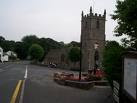


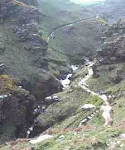





















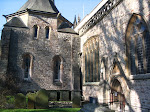
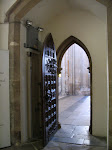







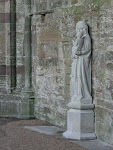












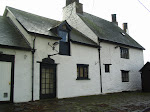
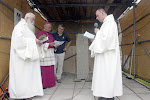





.JPG)


